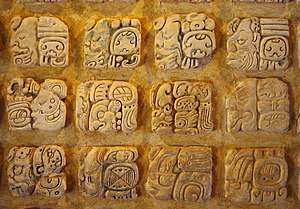
Mesoamerican languages are the languages indigenous to the Mesoamerican cultural area, which covers southern Mexico, all of Guatemala, Belize, El Salvador, and parts of Honduras, Nicaragua and Costa Rica.[1][2] The area is characterized by extensive linguistic diversity containing several hundred different languages and seven major language families. Mesoamerica is also an area of high linguistic diffusion in that long-term interaction among speakers of different languages through several millennia has resulted in the convergence of certain linguistic traits across disparate language families. The Mesoamerican sprachbund is commonly referred to as the Mesoamerican Linguistic Area.
The languages of Mesoamerica were also among the first to evolve independent traditions of writing. The oldest texts date to approximately 1000 BCE (namely Olmec and Zapotec), though most texts in the indigenous scripts (such as Maya) date to c. 600–900 CE. Following the arrival of the Spanish in the 16th century, and continuing up until the 19th century, most Mesoamerican languages were written in Latin script.
The languages of Mesoamerica belong to 6 major families – Mayan, Oto-Mangue, Mixe–Zoque, Totonacan, Uto-Aztecan and Chibchan languages (only on the southern border of the area) – as well as a few smaller families and isolates – Purépecha, Huave, Tequistlatec, Xincan and Lencan. Among these Oto-Manguean and Mayan families account for the largest numbers of speakers by far – each having speakers numbering more than a million. Many Mesoamerican languages today are either endangered or already extinct, but others, including the Mayan languages, Nahuatl, Mixtec and Zapotec, have several hundred thousand speakers and remain viable.